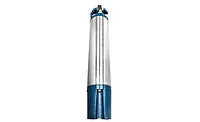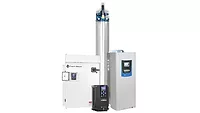Motor Efficiency: Sneaky Realities
Pumping professionals face the ever-growing daily challenge of recommending and installing the most efficient system for customers. Digging through the uncertainties of efficiency regulations, mandates and parameters is tough, especially when efficiencies alone don’t tell the whole story. Sometimes the most efficient motor isn’t the best choice. Knowing what to evaluate and trust will go a long way in helping you make the right decision. Every penny counts, and by identifying two simple calculations you can figure out the best motor — along with the best pump and control/drive — for each application.
Efficiency Standards Tell the Truth
To help both consumers and installers, nearly every product sold today features an energy cost or energy star rating. Industry standards and regulations developed by a coalition of industry experts help control these costs, benefiting the entire industry. The National Electrical Manufacturers Association (NEMA) and the International Electrotechnical Commission (IEC), for example, are multinational organizations. The Brazilian National Standards Organization (ABNT) and Standards Australia (ASNZS) are continent specific standards, but these organizations attempt to harmonize to the international standards of NEMA or IEC. Their goals: to save the customer money on energy costs and save the power company on infrastructure costs. Power lines only carry so much power, so as we continue to use more electricity the power companies are working to supply this demand efficiently. These standards and regulations help them do so by reducing or eliminating confusion in methods of measurement, standard terminology and consistency in product labeling. This also minimizes misleading nomenclature, incorrect measurements or creation of false competitive advantages. All reputable manufacturers support and work with agencies like NEMA and IEC to maintain the professional standards of the organization. So, recommendation number one is to always ensure the products you’re using adhere to these standards. If you are unfamiliar with these standards, you can learn more at www.nema.org or www.iec.ch.
Who & What to Trust
When it comes to motors, most pump installers gravitate to motors that report higher efficiencies because they believe it will provide inherent benefit both at time of installation and in future cost savings. Proceed with caution and check the standards first. If it weren’t for regulatory standards, a company could label their product something like “super-efficient” or make similar false claims. In reality, what defines “super-efficient”? If Company ABC invests in the original design of a product and increases its efficiency by 16 percent, does that meet the criteria? Let’s look at this example as if we are part of an agency now. Company ABC has a newly designed 100 horsepower system. The previous product was 38 percent efficient, and the new product is 54 percent efficient — so they are applying for a Premium efficiency label. The minimum standard to be labeled Premium is 68 percent efficient; therefore it cannot carry the Premium label. Agencies and certifying bodies prevent manufacturers from making claims that do not meet standards.
Now that you know the motor efficiency is correct, how do you know which one works best in your application? Submersible motors are generally 80 percent-plus efficient, while similar surface motors are generally 90 percent-plus efficient. So, a submersible motor is less efficient, right? This is not necessarily the case because we have not included the pump end efficiency in the assessment. Nor have we considered a common misconception that is overlooked: the horsepower requirements based upon the speed of the motor — this will be discussed later in this article.
Step 1 — Measure WWE
The first step is to measure true efficiency by analyzing the complete wire to water efficiency (WWE) of the pumping system. WWE = [(Mtr Eff) X (Pump Eff) X (Control/Drive Eff)] X 100 The obvious applies: You will never achieve 100 percent efficiency if any component within your system is less than 100 percent efficient. Let’s look at two examples with a Franklin Electric motor:
Example 1 — 50HP 2 Pole (3,600 rpm) Pumping System:
The system has an 84 percent efficient motor, 45 percent efficient pump and 99 percent efficient control/drive. Its wire to water efficiency is 37.42 percent.
(.84 motor X .45 pump X .99 control/drive) X 100 = 37.42 percent WWE
Example 2 — 60HP 4 Pole (1,800 rpm) Pumping System:
This system has a 90 percent efficient motor, 76 percent efficient pump and the same 99 percent efficient control/drive. Its wire to water efficiency is 67.72 percent.
(.90 motor X .76 pump X .99 control/drive) X 100 = 67.72 percent WWE
When the Most Efficient Motor Really Isn’t
In researching efficiency output expectations, be cautious when choosing the proper motor efficiency because most will have a Full Load (FL) and a Service Factor (SF) efficiency rating. This is dependent upon the load point from the pump. When selecting the load point, reference the total horsepower requirements needed. If the horsepower is at the rated Full Load point, use this efficiency. Or, if the load point is at the Service Factor rating, then use this efficiency. Having the correct efficiency rating is as important as the total system efficiency. Most pumps will list a BEP (Best Efficiency Point). Don’t just use this for your calculation. Instead, to establish the pump efficiency, look at the head point on the efficiency curve (Figure C). After gathering the control/drive details, you can simply plug the data points into the formula.
Why do we analyze all of these numbers so closely? They all represent a cost position. Installers and designers of pumping systems desire a similar goal — to provide the most efficient and cost effective operating system to their customers. If we only look at total system product efficiency as noted above, then we may overlook the energy consumed by the system. Differences in speed and horsepower in a system can result in higher energy costs, even when they are perceived as more efficient because of efficiency ratings. Start by analyzing the application needs. Some areas may be running for only a couple months out of the year, others may be running every day to supply water to a city/municipal system. In that case, the cost of operation is paramount as the system is going to run for years, whereas the lower duty product may only be operating for a few days in one year’s time. While the energy cost for a continuous run system will be much higher than that of a short run, the savings calculation is similar — however, the amount of savings will be diminished by the amount of run time.
Step 2 — Measure Energy Cost
Let’s figure the second calculation regarding efficiency: energy cost. All power companies charge for kWh (kilowatt hours). The rate varies by location and provider, so we will use $0.20 per kWh for our examples. Regardless of whether your application is submersible or surface mounted, motor speed and horsepower must be analyzed to determine kWh used. And, whether you are installing a submersible pumping system, a line shaft turbine or a centrifugal system, the calculations are all the same. Carefully research your data, perform the calculation, and don’t forget that your control/drive will have an efficiency point to include. This will provide you with the complete system cost. Let’s analyze energy cost using the same two pumping system examples from Step 1:
Example 1 — 50HP 2 Pole (3,600 rpm) Pumping System:
If you recall from above, the system was 37.42 percent efficient. The motor consumes 49 kWh (50 horsepower motor from Figure A) operating 24/7 for 30 days for a total of 35,280 kW consumed. At $0.20 per kWh, the power cost per month is $7,056.
49 X 24 X 30 = 35,280 kWh X $0.20 = $7,056
Example 2 — 60HP 4 Pole (1,800 rpm) Pumping System:
This system seemed to be the clear efficiency leader at 67.72 percent efficient. The more efficient motor in a line shaft turbine system is 4 pole (slower speed) but requires a 60 horsepower motor to generate the same head and flow. Again, operating 24/7 for 30 days, this motor consumes 62 kWh and 44,640 kW per month for a cost of $8,928.
62 X 24 X 30 = 44,640 kWh x $0.20 = $8,928
As you continue sizing, developing and preparing quotes and systems for your customers, motor and pump efficiencies are a great place to start. But, when you calculate the final system cost for your customer, make sure you not only include the capital expenditure of the equipment cost, but also include the energy cost of the system. Often, the most “efficient system” may not be the most cost efficient system. Measuring efficiency and energy cost will offer the customer more insight into their total cost of ownership. This will also translate into a transparent relationship with the customer and ultimately greater satisfaction.
Looking for a reprint of this article?
From high-res PDFs to custom plaques, order your copy today!



